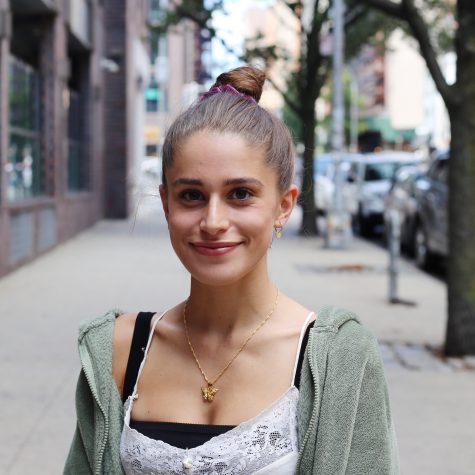Breaking an Olympic record, in warmups at that, is no easy feat. Neither is building a career on short fiction. On Thursday, NYU’s creative writing program hosted two established authors, Amy Hempel and Casey Legler, for a reading at the historic Lillian Vernon House on West 10th Street. Darin Strauss, award-winning author and NYU faculty member, hosted the event.
Since publishing her first book in 1985, Hempel has distinguished herself as a master of short-form fiction. Known for her sparse, minimalist style, she is one of the few writers in history to gain literary acclaim almost exclusively for short stories. Strauss introduced her as “a national treasure.”
“I break the world record split at warm-ups and everyone on deck stops what they’re doing and looks over at coach,” Legler writes in her book “Godspeed: A Memoir,” which was published in 2018. It’s true: the day before the 1996 Summer Olympics, Casey Legler broke the world record in qualifying heats.
Since then, she has worked as a restaurateur, model and, most recently, a writer. When Strauss asked how she’s managed to “be good at multiple things,” she replied dryly, “autism,” before breaking into laughter and saying, “that was a bad joke.”
She said that while she often hated swimming, especially when she was pursuing it at the Olympic level, she has always loved writing. She said it is an honor to call herself a friend of Hempel’s; the pair continually sang one another’s praises throughout the evening. At 6 feet 2 inches, Legler is sinewy and striking, sporting an array of tattoos, a chiseled jaw and a gracious smile. Hempel is miniature beside her, with long white hair and dark eyes.
In March 2019, Hempel released “Sing to It,” her first book in 10 years. Of the 15 stories in the collection, 10 are what she calls “short shorts,” otherwise known as flash or micro fiction, many of them under a page in length.
When asked if she would ever attempt to expand one of these shorter works, she responded that she wouldn’t, claiming that her longer works, such as her novella “Tumble Home,” were essentially accidents.
After reading two of her short shorts, Hempel self-deprecatingly introduced the excerpt of an unpublished nonfiction piece she would read next, gesturing to Legler as the verifiable memoirist.
One thing the two writers have in common: water. Hempel’s nonfiction piece meditates on her childhood days spent swimming in a pond by her house and discovering that her father was not really her father. Associative yet tight, sparse and cutting, it is marked with all of the Hempelian qualities of her short fiction.
Legler’s connection to water is more apparent, but she also discusses it through the lens of adolescent angst, recalling showing up hungover to swim practice and breaking a record nevertheless.
“I don’t know if I’ve ever wrote anything that hasn’t relied, for some part of its impact, on water,” Hempel said. Legler nodded in agreement; of the seven years she spent swimming competitively, she spent three and a half underwater — she did the math. “That has to do something to a person,” she joked.
She read an excerpt from “Godspeed” about being 15 years old, a closeted lesbian in love with her best friend. Often hilarious, Legler narrates a high school sleepover with sharp wit and adolescent optimism.
She then read from the end of the book — “Why not?” she said — which proves heavier in content, a moving depiction of her battle with drug addiction at 20 years old. The humor of the earlier excerpt, however, remains laced throughout. She cites the humor in her prose as her way of helping the reader “sustain the onslaught of the book.”
She found it difficult at times, writing in first person, to summon the cavalier attitude of her youth. But she’s clear that she was not an easy child, teen or young adult, describing the fact that she’s so frequently referred to as “nice” in adulthood as a miracle. “That is not how anyone would have described me back then,” she said.
Much time was spent uplifting the work of others. When one attendee asked what makes a short story good, Hempel responded, “Do you write short stories?” When he said that he did, she smiled widely and cheered.
“Ego is out the window when you look around these days, in any which direction,” Hempel said. Worried less about accolades than ever before, she noted her attention has been focused on the crisis at the border. She expressed her admiration for the work of Mexican writer Valeria Luiselli, especially her recent novel “Lost Children Archive.”
Strauss asked both writers about their nonconformist writing styles. Legler cited an aspiration to emulate the “freedom of irreverence” she saw in the works of writers like Jack Kerouac and Charles Bukowski, but notes that when it came to actually writing, her goal was to “create a liminal, physical quality” that the reader could experience. Any disregard for traditional form was merely a symptom of this effort.
Similarly, Hempel said she strives to write stories that are what she calls “headlong” and finds the most effective way to do this is often through less conventional means. Her aim is not to be subversive, but rather to get the story to do what she wants it to do.
After the reading and Q&A, the audience was invited to the far room of the first floor for wine, refreshments and a book signing.
The Reading Series hosts events every Thursday and Friday throughout the semester, all of which are free and open to the public. The next reading will take place on Thursday and feature award-winning poet Brenda Shaughnessy in conversation with the creative writing program director Deborah Landau.
The Lillian Vernon Creative Writers House is located at 58 W 10th St.
A version of this article appears in the Monday, Sept. 9, 2019 print edition. Email Julie Goldberg at [email protected].
























































































































































